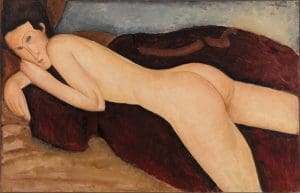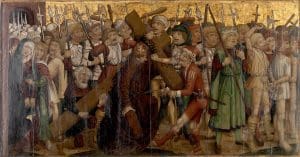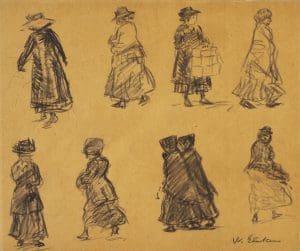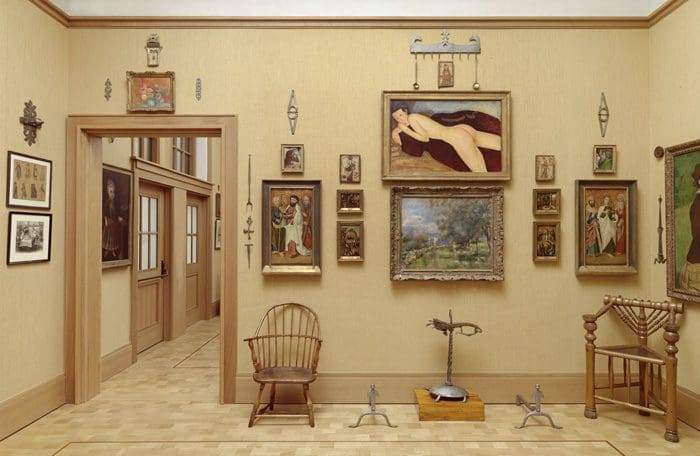Exploring the contents of Room 21
Above image: Ensemble view, Room 21, south wall, The Barnes Foundation, Philadelphia, Pennsylvania. 2016.

Amedeo Modigliani, Italian, 1884–1920. Reclining Nude from the Back (Nu couché de dos), 1917. Oil on canvas, 25 1/2 x 39 1/4 in. (64.8 x 99.7 cm). BF576, The Barnes Foundation, Philadelphia, Pennsylvania. Image © 2016 The Barnes Foundation
On September 9, Jace Clayton (aka DJ /rupture) will premiere his latest work Room 21 at the Barnes Foundation as part of the 2016 Fringe Festival. Co-presented with the Barnes Foundation and curated by Lee Tusman in collaboration with Ars Nova Workshop, the site-specific performance is an inspired musical response to the artworks of Room 21 at the Barnes Foundation and Albert Barnes’ extensive record collection. Joining Clayton is an ensemble of more than a dozen musicians, including the Prometheus Chamber Orchestra, banjoist Ben Lee, Ethiopian Musician Gezachew Habtemariam and Pianist Emily Manzo, all wearing custom costumes handcrafted by fashion designer Rocio Salceda of Prellezo. This is a remarkable one night only event, an inspired engagement with one of Philadelphia’s most storied institutions. For more info and tickets click here.

Austrian. Christ Carrying the Cross, c. 1460. Tempera and oil with gold and silver leaf on panel, 29 3/8 x 51 1/2 in. (74.6 x 130.8 cm). BF396, The Barnes Foundation, Philadelphia, Pennsylvania. Image © 2016 The Barnes Foundation
When Jace Clayton first found himself in Room 21 of the Barnes Foundation he was struck by what seemed to him an extremely personal organizational logic. It’s a well known fact that Albert Barnes held strong to his personal, cultivated aesthetic theories, but never imposed them on his visitors beyond his arrangements. Presenting his collection without the curatorial commentary museum attendees often expect, he created spaces for viewers to approach each piece free from explicit outside mediation. Room 21, Clayton found, encapsulated this kind of aggressive formalism. With one hundred and thirty pieces contained within its four walls, the small space intermingles renowned masters and unidentified artisans, the functional and the ornamental, the sacred and the profane.

Possibly Bamana or Marka peoples. Mask, late 19th–early 20th century. Wood, resin, 24 x 7 5/8 x 6 7/8 in. (61 x 19.4 x 17.5 cm). A224. Photo © 2016 The Barnes Foundation
One of the room’s most famous work, Amedeo Modigliani’s Reclining Nude from the Back, hangs adjacent to and across from various Northern European religious paintings possibly dating back to the 15th century. Directly across from the nude by the young artist of whom Barnes was an early champion, is the large tableau Christ Carrying the Cross. This juxtaposition may have offended some of the foundation’s Christian visitors, and it’s amusing to imagine Barnes finding a punkish glee in creating it. Still, one must assume he knew exactly what he was doing as such curation is in line with his formalist leanings. It requires of viewers to divorce any beliefs they may hold that are irrelevant to the physical work itself.

William James Glackens. American, 1870–1938 . Eight Figures, c. 1910 . Black crayon with gouache on brown wove paper , 12 1/8 x 14 3/8 in. (30.8 x 36.5 cm) . BF641, The Barnes Foundation, Philadelphia, Pennsylvania. Image © 2016 The Barnes Foundation
It is in part this disregard for context that makes the foundation, and Room 21 in particular, such an anomalous gem among other art institutions. Where most curate their collections around specific artists, movements, or mediums, here visitors are treated to a trove of fine art and meticulously crafted objects from all over the world, side by side. In Room 21 alone, displayed among three separate cases are numerous 19th–early 20th century figures, masks, and tools from various African ethnic groups; adorning the wall space around notable paintings are an assortment of ornate bolts, keyhole escutcheons, tools, hinges, and latches, among other functional objects; and there are also elegant, handcrafted chairs placed around the perimeter. The space feels relative to how people let art inhabit their lives, which stands in opposition to much traditional curation that aims to convey contextual and historical narratives alongside the art. The only hints of narrative that exist in Room 21 suggest something far more personal.

Senufo peoples. Seated Female Figure, late 19th–early 20th century. Wood. 34 1/2 x 12 3/4 x 11 in. (87.6 x 32.4 x 27.9 cm). A209. Photo © 2016 The Barnes Foundation
The room’s east wall is starkly unadorned compared to the others because of a large window and viewing bench sitting center, but hanging adjacent on either side are a few notable pieces. Two drawings which hang together on one side of the window—There Was Edward Bickford’s Racing Cup (1909) and Eight Figures—are by William James Glackens, a close friend of Barnes’ from his days at Philadelphia’s Central High School. Glackens later became an artist and advised Barnes in his early purchasing endeavors. In turn, Barnes became Glackens’ most important patron. On the opposite side of the window hangs a 1941 painting from Turkish born, New York based artist Aristodimos Kaldis entitled Absorbing Art (1941). It depicts a man sitting in a museum ostensibly doing exactly what the title suggests, and feels a fitting companion to Glacken’s presence.
When a visitor takes a seat in Room 21 there’s something curious at play. Two pieces by the man who encouraged Barnes to engage with art hangs over one shoulder, a depiction of a man doing just that hangs over the other, and placed in the center of the room is Seated Female Figure, staring the viewer down, as if to challenge them to truly take it all in.
– Hugh Wilikofsky



